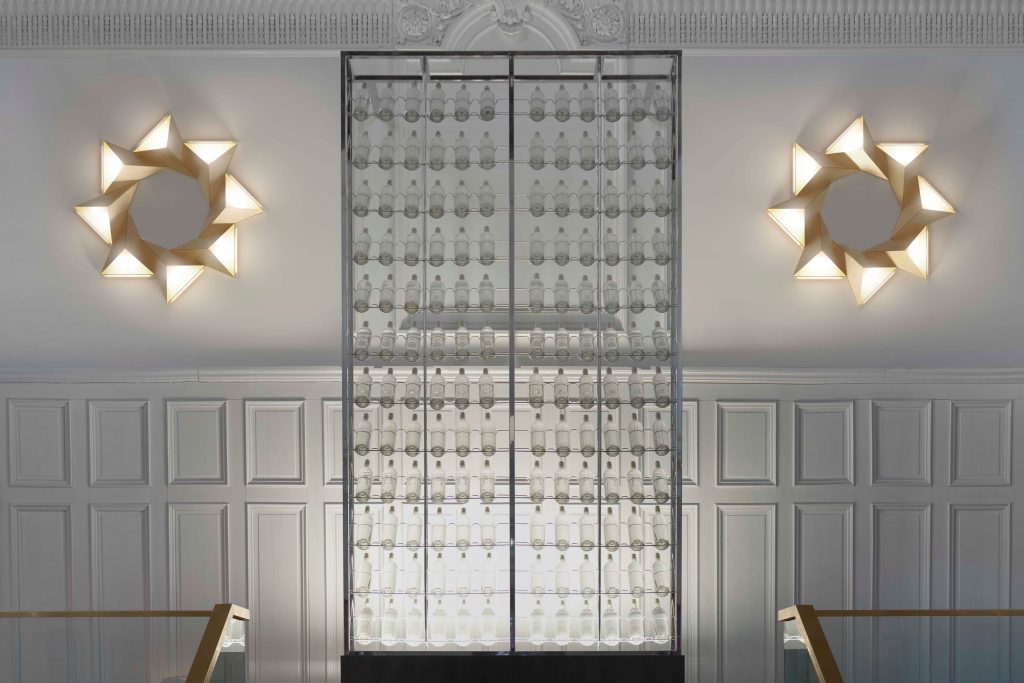Choosing and installing wall sconces

Choosing wall sconces
Most sconces will illuminate a wall. Visually, brighter vertical surfaces contribute more to the perceived brightness of a room, than horizontal surfaces.
The sconces usually provide a diffuse light, that contribute to the overall brightness of the room. This means that sconces will rarely be chosen in isolation of the overall room lighting. The light’s colour and tone are also important parameters: warm colour for a cozy atmosphere, colder for a “technical” atmosphere or style.
Sconces are rarely suitable for the complete lighting of a room. The light they provide is light is too homogeneous, struggles to highlight particular areas of interest, and does fails to highlight volumes. A few exceptions are:
- Narrow corridors, which often lack areas of interest to highlight;
- Bathrooms, where sconces are traditionally installed on both sides of the mirror above the basins.
The best visual effect is often obtained by illuminating the wall that supports the sconce, and the backlit models are designed with this intent. Some models also illuminate downwards, drawing a portion of ellipse on the wall, and another on the ground below.
Sconces with light-coloured or transparent shades will benefit from a dimmer (usually installed in place of the existing wall switch). The adjustment of the light intensity, will then allow a softer light, and avoid any glare.
Many models of sconces have transparent glass panes, that leave the bulb directly visible. This is the case of many models of outdoor sconces. We do not recommend compact fluorescent bulbs for these types. A standard eco-halogen or LED bulb and the addition of a dimmer are good choices. A better solution is to use a decorative filament bulb – such as those recommended by the manufacturer TEKNA – sometimes called navigation bulbs – although they have now become quite common everywhere. These bulbs are supplied with a lower tension which turns the filament into a warm glowing shape, for a quite pleasing visual effect without risk of glare.
Sconces are often installed in pairs. Three, four or five identical copies on the same wall can produce a truly successful alignment effect, reinforcing the impression of structure and length, thereby enlarging the room.
The installation
From the point of view of the installation, it is of course necessary to ensure the presence of an electrical inlet at the location provided for each wall. This input is connected to a wall switch – which can often be replaced by a dimmer switch. From this point of view, the installation of sconces is either opportunistic (using the existing connections that are in the right place) or must be carefully planned at the time of the refurbishment. The height at which these electrical connection is important: many sconces are not designed to be seen from below and some electricians tend to set the junction boxes too high…
Finding them on our site
You will find a broad collection of superb sconces on our site, of very different styles:
- Our contemporary wall-lights, with a large variety of styles but always selected for the quality of their fabrication and for the originality of their design;
- Our classical wall-lights, in particular by Lucien Gau who for the last 150 years has been reproducing superb bronze models from the Dutch, Louis XII, Louis XIV, Louis XV, Louis XVI, Empire and Directoire, of by Estro in Italy following broader inspiration but with the same impressive quality;
- And our selection of outdoor sconces, with manufacturers like Faro, Nautic and Objet Insolite (still more are visible on our French site, with Robers, Aldo Bernardi, FIne Art Lamps, Royal Botania…).
* * *
You can find further guidance in the following page:
- Our advices to dimension your lighting and choose your fixtures: the principles of lighting design.
- Which types of bulbs you should choose, from all the technologies now on the market - fluo-compact, LEDs etc: what you need to know about bulb technologies.
- How you should choose the LED you need, depending on your room and your expectations in terms of lighting (there is more to it than what you can read on most bulb packages): our guide to choosing LED bulbs.
- Explanation of what the various lighting units mean, and how to use them: how to speak the jargon, with lux, lumen and candela!.
- Use our calculators to size your lighting according to its purpose: our lighting calculators.
- Find your way in the jungle of the various European bulb types: our simple guide to the various bulb models.
- Read our advice on why you could consider connected lighting, and how you can jump on the train without the headaches: starting with connected lighting.
You can also find below our advice to choose and install the various types of lighting you can find in our catalogue:
- suspensions, chandeliers and pendants
- Table and desk lamps
- Wall lights
- Lighting beacons for circulation areas (indoor or outdoor)









